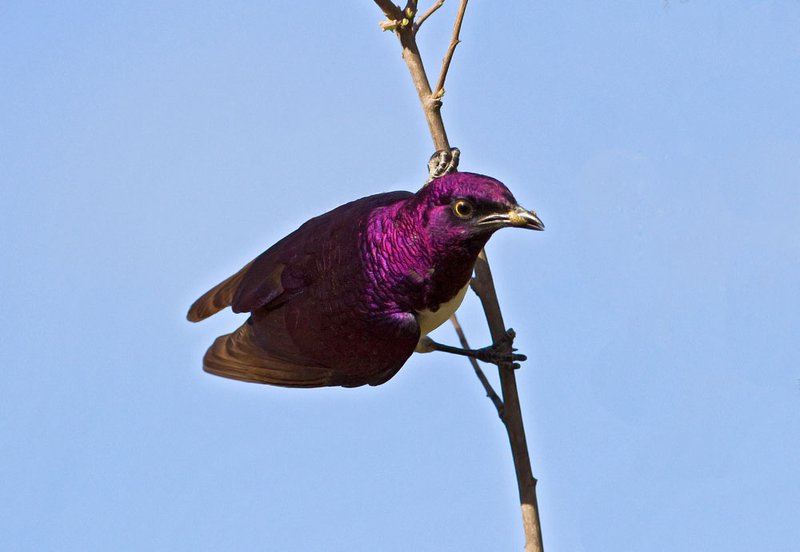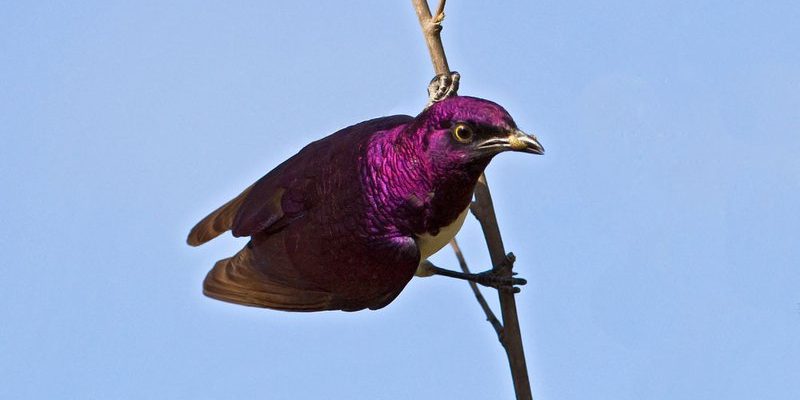
Imagine wandering through a sun-dappled jungle, the air buzzing with the sounds of life. Suddenly, a flash of shimmering color catches your eye—a violet-backed starling perched gracefully in a branch. With its vibrant plumage and lively personality, this bird certainly knows how to steal the spotlight!
The violet-backed starling, known for its striking iridescent feathers, is more than just a pretty face. This bird plays a significant role in its ecosystem and captivates birdwatchers across Africa. Let’s dive into the world of this fascinating avian creature and discover what makes it so unique.
Physical Characteristics
One of the most noticeable aspects of the violet-backed starling is its breathtaking coloration. Males are dressed in striking iridescent purple and blue feathers, while females are a bit more understated, sporting a browner palette. This vibrant display isn’t just for show; it plays a crucial role in mating. The male’s bright plumage attracts potential mates, making it a visual treat during the breeding season.
When it comes to size, the violet-backed starling is relatively small, measuring about 23 centimeters in length. Their bodies are sleek, and they have sharp, slightly curved beaks that help them forage for food. These adaptations allow them to thrive in various habitats, from open woodlands to savannas, showcasing their ability to adapt.
Another fascinating feature is their eyes, which are bright and expressive, reflecting their curious and lively nature. Pair that with their bold personalities, and it’s no wonder these birds are a joy to observe. The combination of striking looks and charming behavior makes the violet-backed starling a standout species!
Habitat and Distribution
The violet-backed starling is primarily found in various regions across sub-Saharan Africa. These birds enjoy a mix of forest and open habitats, with a preference for woodlands, grasslands, and even urban areas, where they can easily find food. Their adaptability to different environments allows them to thrive in places with a diverse range of vegetation.
Typically, they stay near water sources, such as rivers and lakes, which provide essential drinking water and abundant foraging opportunities. The lush surroundings not only serve as a food source but also provide shelter from predators. When observing them, you might spot these birds flitting between trees or hopping along the ground, foraging for insects and fruits.
Interestingly, violet-backed starlings are often found in mixed-species flocks, which helps them navigate their environment and increase their chances of finding food. This social behavior is a fascinating aspect of their lifestyle, enabling them to benefit from teamwork when foraging and staying alert to any potential dangers.
Diet and Feeding Habits
The violet-backed starling is an omnivorous bird, which means its diet consists of a mix of fruits, insects, and sometimes even seeds. They have a particular fondness for ripe fruits, which they search for in trees and bushes. When the fruit is in season, you can see them dining on juicy berries and other delectable treats, making them key players in seed dispersal within their habitats.
In addition to fruits, these birds are also skilled insect hunters. They forage actively on the ground, pecking at the soil or leaf litter to uncover hidden insects. You might say they are like little detectives, using their sharp eyesight to spot their next meal. Their feeding habits not only showcase their adaptability but also contribute to a healthy ecosystem by controlling insect populations.
What’s more, violet-backed starlings exhibit clever foraging techniques, sometimes even following larger animals to catch insects that are disturbed during the larger animal’s movement. This behavior highlights their resourcefulness and the ways they interact with fellow creatures in their environment.
Breeding and Nesting
During the breeding season, which typically occurs between August and December, male violet-backed starlings put on quite a show to attract females. With their dazzling feathers and spirited calls, they create a lively display. Once a pair forms, they begin the nesting process, usually in tree cavities or in old nest structures left by other birds.
The female lays about 2 to 4 eggs, which she incubates for approximately two weeks. After hatching, both parents take an active role in feeding their young. This shared responsibility not only strengthens their bond but also ensures the chicks receive proper nourishment as they grow.
As the chicks develop, they begin to rely on both parents to bring food back to the nest. Watching this family dynamic is truly heartwarming, showcasing the parental instincts and commitment of these birds. Once the young starlings are ready to leave the nest, they will join their parents in foraging, learning the ropes of survival in their vibrant habitat.
Behavior and Social Structure
The violet-backed starling exhibits a variety of interesting behaviors that make them a joy to observe. They are known for their playful nature, often seen chasing each other around trees or engaging in vocal sparring matches. Their social structures are fascinating, as they often gather in groups, especially when foraging.
Within these flocks, you’ll notice a hierarchy where certain individuals take the lead in discovering food sources. This cooperation maximizes their foraging efficiency and keeps them safe from predators. It’s like a well-rehearsed dance, with each bird knowing its role and place within the group.
During the day, violet-backed starlings are quite active, engaging in various activities such as preening, sunbathing, and interacting with one another. This lively behavior not only reinforces their social bonds but also keeps them alert and aware of their surroundings. Observing these interactions can be quite entertaining, offering a glimpse into their dynamic world.
Conservation Status
Currently, the violet-backed starling is classified as Least Concern by the IUCN Red List, indicating that it is not facing immediate threats to its survival. Their adaptable nature and ability to thrive in various habitats have allowed them to maintain stable populations. However, that doesn’t mean they are entirely without challenges.
Habitat destruction due to deforestation and agricultural expansion poses a threat to their environments. As humans encroach on their territories, these birds may find it increasingly difficult to locate suitable nesting sites and food sources. This highlights the importance of conservation efforts to protect their habitats and ensure their future.
Moreover, raising awareness about biodiversity and the role of species like the violet-backed starling can encourage conservation initiatives. By fostering an appreciation for these beautiful birds and their ecosystems, we can contribute to their preservation for generations to come. Every small effort counts in ensuring that these vibrant creatures continue to grace our landscapes.
| Characteristic | Details |
| Size | Approximately 23 cm in length |
| Coloration | Males: Iridescent purple and blue, Females: Brown |
| Diet | Fruits, insects, and sometimes seeds |
| Habitat | Sub-Saharan Africa; woodlands, savannas, and urban areas |
| Breeding Season | August to December |
| Conservation Status | Least Concern |
FAQ
What is the lifespan of a violet-backed starling?
The lifespan of a violet-backed starling in the wild typically ranges from 5 to 10 years. However, factors like environmental conditions, predation, and availability of food can affect their longevity. In some cases, birds in captivity may live longer due to better care and absence of threats.
Are violet-backed starlings migratory?
Violet-backed starlings are generally non-migratory. They tend to remain in their preferred habitats year-round, adjusting their movements based on the availability of food and nesting sites. This stability allows them to establish strong social structures and breeding practices.
How can I attract violet-backed starlings to my garden?
If you want to attract violet-backed starlings to your garden, consider planting native fruit-bearing plants and providing water sources like bird baths. These birds love fruits and will be drawn to areas where they can forage. Also, keeping your garden habitat-friendly helps maintain a welcoming environment.
What are their main predators?
Violet-backed starlings face various predators, including larger birds of prey, snakes, and even domestic cats. These threats can disrupt their nesting and foraging habits, making it essential for them to remain vigilant and aware of their surroundings while they seek food or raise their young.
Do violet-backed starlings have any unique vocalizations?
Yes! Violet-backed starlings are known for their melodious and varied vocalizations. Their calls can range from soft whistles to more complex sounds during their social interactions. This vocal repertoire plays a crucial role in communication, especially during the breeding season when attracting mates is essential.
What is the significance of their iridescent plumage?
The iridescent plumage of male violet-backed starlings is not only visually stunning but also serves an important purpose in their mating rituals. Bright colors attract females, signaling health and vitality. This display of brightness can give males an edge in reproductive success.
Can violet-backed starlings live in urban areas?
Absolutely! Violet-backed starlings are quite adaptable and can thrive in urban environments. They often take advantage of parks and gardens that provide food sources, such as fruit trees and gardens, making them a common sight in cities across their range.
How do starlings find food?
Violet-backed starlings are quite resourceful and rely on their keen eyesight to locate food. They forage on the ground, search in trees, and even observe other animals to find insects. This behavior highlights their adaptability and intelligence in securing food.
Are there any threats to their population?
While the violet-backed starling is currently classified as Least Concern, threats such as habitat destruction and climate change can impact their populations in the long run. Conservation efforts and habitat protection are essential to ensuring they continue to thrive in the wild.
What role do violet-backed starlings play in their ecosystem?
Violet-backed starlings play a vital role in their ecosystems as seed dispersers. By consuming fruits and then excreting the seeds in different locations, they help maintain plant diversity and support the growth of new plants. Their foraging habits also help control insect populations, benefiting the environments in which they live.
How do violet-backed starlings care for their young?
Both male and female violet-backed starlings actively participate in caring for their young. After the eggs hatch, they work together to feed the chicks a diet rich in insects and fruits. This cooperative parenting not only strengthens their bond but also increases the survival rate of their offspring.
Can I observe violet-backed starlings in the wild?
Yes! If you find yourself in sub-Saharan Africa during the right season, you might have the chance to observe violet-backed starlings in their natural habitat. Look for them in woodlands, savannas, or even urban parks. Just remember to be patient and quiet, and you might catch a glimpse of these vibrant birds!

